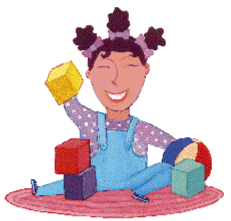By Carri P. Jenkins
Four-year-old Suzy can read her brother’s third- grade reader and count all the way to 100, but that doesn’t mean she is any more ready for school than your child, says an expert in early childhood development at BYU.
“We see children all the time at the university-based preschool who can read on a fourth- and fifth-grade level,” says Jean M. Larsen, who has coordinated the early childhood education program at BYU for the past 15 years and has worked with the BYU preschool for more than three decades. “And this is great–if they understand what they are reading. But too often these children can’t interpret what they’ve just read.”
A long-time advocate of horizontal rather than vertical learning for preschoolers, Larsen believes children are better off if they come to school “wanting” to learn rather than touting a checklist of skills they can do.

“Play is exactly how preschoolers learn. They don’t need the skill, drill, and kill routines.” – Ann Larsen
Knowing your alphabet is only a piece of the puzzle, she says. “Understanding that these symbols represent meaning, such as a child’s name and directions on a street sign, is far more important.”
First identified as a national goal at the 1989 Education Summit, school readiness has become a focus for professional educators. Too many parents, however, are still unaware of the difference between being “ready” for school and being “prepped” for school.
The difference is that a child who is ready for school can build connections, says Ann Larsen, a professional kindergarten teacher who spent this summer as a head teacher at BYU’s preschool.
“For instance,” she says, “children who are ready for school know that by combining certain letters of the alphabet they can spell the names of people they love. But children who don’t understand this association have nothing to connect these symbols to.”
In working with parents, Ann often asks them to write several Chinese characters and then memorize them. It’s a difficult, boring assignment, and the parents quickly realize that this is what a preschooler feels like in learning the alphabet.
Having once attempted this task, parents are much more enthusiastic about some of her teaching methods, says Ann, such as “logo language.” Here children learn phonics by gathering and reading the logos of such items as their favorite breakfast cereals, candy bars, and fast-food restaurants. “Have a child bring a box of Cheerios from home, and I guarantee you she will remember what sound ch makes,” adds Ann.
It is this ability to connect concepts and ideas together that educators hope to see in every student.
Larsen, along with several other professional educators, recently outlined for the state of Utah a number of “skills” children should have before they begin school. “It’s not the list most parents would expect to see,” she says.
Listed under the “emergent literacy skills” category are such traits as asking and answering questions, relating events, and understanding that stories have a beginning, middle, and end.
Interestingly, says Larsen, none of these skills require any formal learning. “These are derived from the routines of day-to-day living.”
Ann, who taught her preschoolers this summer everything from spelling to statistics by opening a restaurant one night for their parents, says she was once accused of just “playing” with her students.
“And that’s where we need to educate people,” she says. “Play is exactly how preschoolers learn. They don’t need the skill, drill, and kill routines.”
Yet Ann and Larsen are quick to emphasize that children must be encouraged to think and explore in their play. They also both agree that parents–not teachers–are the best ones to help children do this.
“If parents will just take one minute more and ask their children a question about something, such as a book they are reading together, they will help to significantly extend the curiosity of their children. Then as children find the answers to the questions, they will develop the confidence to ask more questions.”
Although Larsen is convinced that parental involvement–not preschool–is what gives children the big advantage, such involvement is not an exact science. There are, however, some basic guidelines Larsen suggests parents follow:
* Give children your full attention when speaking to them.
* Get down on the child’s level and look encouragingly at the child during conversation.
* Ask questions that would encourage children to share more information.
* Restate and clarify what your child said.
* Identify and restate emotional feelings that were being experienced by your child.
“Parents who will take the time to follow these suggestions will build the foundation children need to start school on,” says Larsen. “You don’t have to spend hours memorizing the alphabet with your child; just talk with them about why buds turn into flowers, why we put numbers on our houses, and why 15 pennies are actually less than a quarter. That’s the kind of base a teacher can build upon.”








